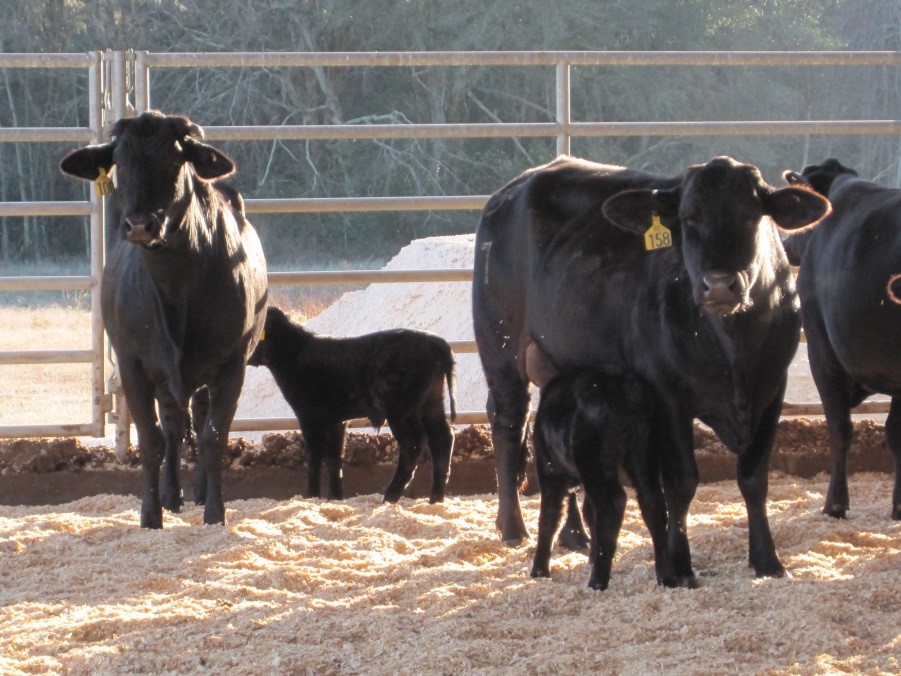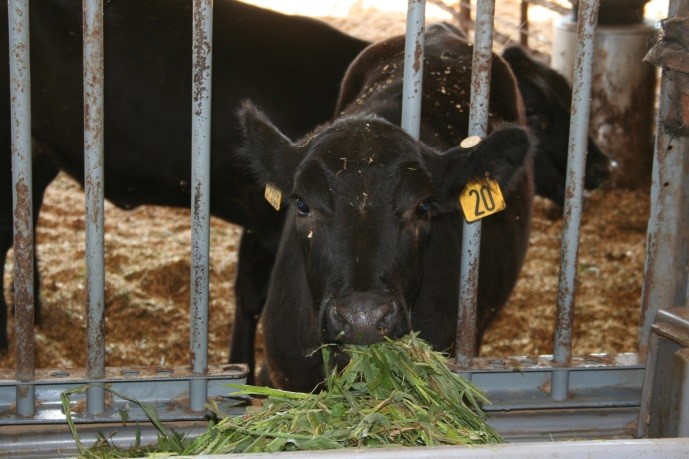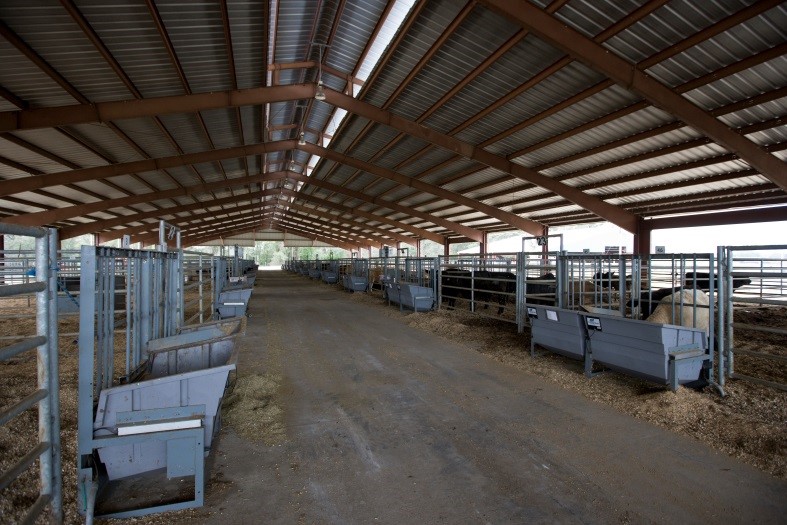
Cow and calf pairs in a feed efficiency study at the North Florida Research and Education Center Feed Efficiency Facility.
Introduction
In Florida, the predominant classes of cattle are females (replacement heifers, young and mature cows) that graze forages. However, most feed efficiency research has focused on grain-fed, feedlot cattle, with little data collected on mature cows on a forage-based diet. Approximately 55 to 75% of the total costs associated with beef cattle production are feed costs. A 5% decrease in feed efficiency could have an economic impact four times greater than a 5% improvement in average daily weight gain. Feedlot studies have demonstrated that a 10% improvement in average daily gain (ADG) as a result of a 7% increase in appetite improved profitability 18%, whereas, a 10% improvement in feed efficiency returned a 43% increase in profits. Thus efforts at improving the efficiency of feed/forage use will have a larger impact on reducing input costs of beef production. For example, in Florida alone with approximately 1.7 million cattle on inventory, a 10% increase in feed/forage efficiency could reduce production costs by at least $34 million annually.
Selecting for Feed Efficiency
Selection for feed efficiency in cattle has traditionally been accomplished by indirect procedures and various management strategies (i.e., not direct selection). Many factors influence feed/forage efficiency including age, diet type, environmental temperature, breed, growth promotants, and many other management and environmental variables. Using residual feed intake (RFI), which is a method of assessing feed efficiency by measuring the variation in feed intake beyond that needed to support maintenance and growth requirements, and is calculated as the difference between actual feed intake and the feed an animal is expected to consume based on its body weight and average daily gain. Therefore, a negative value indicates an animal that is more efficient and a positive value indicates an animal that is less efficient. Selection for RFI in cattle can have dramatic implications in the beef cattle industry. Low RFI cattle consume less feed and have lower maintenance requirements while growth appears to be unaffected. Improving feed efficiency by selecting for RFI also has the potential to reduce animal waste and methane gas production. Generation of RFI expected progeny differences (EPDs) will allow for the selection of more efficient animals. Preliminary data indicate that post-weaning RFI is highly related to mature cow efficiency without reproduction being reduced.
Feed Efficiency in Cows
Improving feed efficiency is not just relegated to growing cattle and some differences may be seen in mature cows. About half of the feed used in beef production systems is used to maintain the breeding herd. Of the remaining 50%, about 20% is used by the breeding cow for pregnancy and lactation, and 30% is used by the growing heifer. Although little work has been validated in lactating and nonlactating beef cows, two studies have indicated that selection for low RFI may have positive effects on future feed intake of mature females.
In an experiment performed in Missouri (Meyer et al., 2008) where non-lactating beef cows fed a forage-based diet, the most efficient cows (top third) consumed about 20 % less forage than the least efficient cows (bottom third). Therefore, when forage is limited, small improvements in efficiency can make a large improvement in cowherd maintenance. Selection of replacement heifers based on efficiency could assist in the reduction of maintenance costs of the cowherd.
In a recently completed experiment at the University of Florida Feed Efficiency Facility in Marianna, feed efficiency was measured in 74 replacement heifers that subsequently were retained until a second feed efficiency period after the same females gave birth to their second calf as 3-year old cows. For both the heifer (Phase I) and cow phases (Phase II), upon arrival into the feed efficiency facility, females were allowed a 14-d acclimation period before initiating a 70 d feed efficiency test. The diet for heifers was a forage-based growing diet (2.1 Mcal ME/kg DM) formulated to meet requirements to support growth rates of approximately 2.2 lbs/day, whereas the diet for cows was a forage-based diet suitable for lactating beef cows in Florida. Milk production was established at day 28 and 84 of lactation for the cows. Residual feed intake was calculated for each animal. Heifers were sorted and placed into Low (<0.5 SD; n = 24), Medium (<0.5 SD>; n = 24), and High (>0.5 SD; n = 26) feed efficiency groups based on their RFI values, with more negative values being efficient and positive values inefficient. Individual heifer RFI values ranged from -2.3 (most efficient) to 2.0 (least efficient) and Individual cow RFI values ranged from -5.8 (most efficient) to 8.5 (least efficient). Cows which were most efficient as heifers (those in the Low group) had significantly lower dry matter intake (DMI) than their counterparts and consumed 4.6 pounds less feed per day than cows that were in the High group as heifers. Therefore, low RFI heifers subsequently became cows that consumed less feed than cows that were categorized as high RFI as heifers.
Cow-calf enterprises require early identification of high quality replacement heifers in order to facilitate the selection of animals which will remain in the breeding herd. Therefore, selection of growing heifers that are highly feed efficient (Low RFI ranking) may become cows that consume less feed without compromising body condition, milk production, or reproductive performance. Although identifying efficient females is complicated, it is easy to see the impact of selecting for more feed efficient heifers on subsequent cow performance.

Heifers consuming forage in the North Florida Research and Education Center Feed Efficiency Facility
- Prebreeding Management for Successful Development of Beef Replacement Heifers - December 16, 2016
- Fetal Versus Maternal Contributions of Bos indicus Genetics to Offspring Growth - July 22, 2016
- Understanding Fetal Programming in Cattle - March 11, 2016

